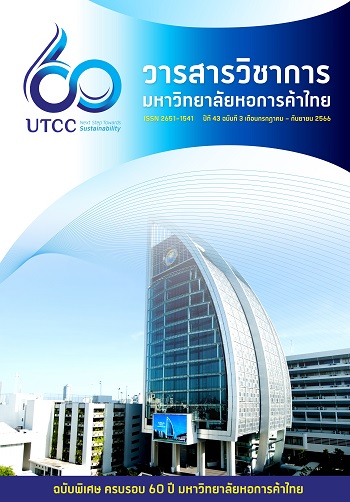Impact of Changes in Capital Flows from Japan, European Union, and ASEAN on Thailand’s Economy
Main Article Content
Abstract
This research aims to develop economic models to study impact of changes in capital flows from Japan, European Union, and ASEAN on Thailand’s economy, and analyse the impact of changes in capital flows from Japan, European Union, and ASEAN on Thailand’s economy in both short run and long run. The results revealed that there was 1 cointegration for each model. The results of long run equilibrium test showed that capital flows in term of foreign direct investment from Japan, capital flows in term of portfolio investment from ASEAN countries, and capital flows in term of portfolio investment from European Union were the variables influencing Thailand’s economic indicators especially real GDP. The results of short run equilibrium test revealed that capital flows in term of portfolio investment from European Union was the variable influencing both real GDP and unemployment rate. It could be recommended that the policy makers should launch some investment supporting scheme such as tax privileges and non-tax benefits as well as increasing investors’ confidence to create opportunity for long run economic growth.
Article Details

This work is licensed under a Creative Commons Attribution-NonCommercial-NoDerivatives 4.0 International License.
ลิขสิทธิ์ของบทความ
ผลงานที่ได้รับการตีพิมพ์ถือเป็นลิขสิทธิ์ของมหาวิทยาลัยหอการค้าไทย ห้ามมิให้นำเนื้อหา ทัศนะ หรือข้อคิดเห็นใด ๆ ของผลงานไปทำซ้ำ ดัดแปลง หรือเผยแพร่ ไม่ว่าทั้งหมดหรือบางส่วนโดยไม่ได้รับอนุญาตเป็นลายลักษณ์อักษรจากมหาวิทยาลัยหอการค้าไทยก่อน
References
ธนาคารแห่งประเทศไทย. (2563). เงินลงทุนโดยตรงจากต่างประเทศ (Inflow) จำแนกตามประเทศ/เขตเศรษฐกิจ และประเภทธุรกิจในประเทศไทย. สืบค้นเมื่อ 7 ธันวาคม 2565, จาก https://app.bot.or.th/BTWS_STAT/statistics/BOTWEBSTAT.aspx?reportID=847&language=TH
ธนาคารแห่งประเทศไทย. (2564). เศรษฐกิจการเงินไทย. สืบค้นเมื่อ 7 ธันวาคม 2565, จาก https://www.bot.or.th/th/thai-economy.html
สำนักงานสภาพัฒนาการเศรษฐกิจและสังคมแห่งชาติ. (2564). ข้อมูลด้านเศรษฐกิจ. สืบค้นเมื่อ 7 ธันวาคม 2565, จาก https://www.nesdc.go.th/more_news.php?cid=74
Aastveit, K. A., Natvik, G. J., & Sola, S. (2013). Economic uncertainty and the effectiveness of monetary policy. Retrieved from https://www.norges bank.no/contentassets/2450536cb556427f932fdcd256c5af16/norges_bank_working_paper2013_17.pdf?v=03/09/2017123319
Ahmed, S., & Zlate, A. (2014). Capital flows to emerging market economies: A brave new world? Journal of International Money and Finance, 48, 221-248. doi:10.1016/j.jimonfin.2014.05.015
Ahmed, S., Coulibaly, B., & Zlate, A. (2017). International financial spillovers to emerging market
economies: How important are economic fundamentals? Journal of International Money and Finance, 76, 133-152. doi:10.1016/j.jimonfin.2017.05.001
Baharumshah, A. Z., & Thanoon, M. (2006). Foreign capital flows and economic growth in East Asian countries. China Economic Review, 17(1), 70-83. doi:10.1016/j.chieco.2005.09.001
Bosworth, B., & Collins, S. M. (1999). Capital flows to developing economies: Implications for saving and investment. Brookings Papers on Economic Activity, 59,143-180. doi:10.2307/2534664
Bruno, V., & Shin, H. S. (2012). Capital flows and the risk-taking channel of monetary policy. Retrieved from https://www.bis.org/publ/work400.pdf
Cai, Z., Chen, L., & Fang, Y. (2018). A semiparametric quantile panel data model with an application to estimating the growth effect of FDI. Journal of Econometrics, 206(2), 531-553. doi:10.1016/j.jeconom.2018.06.013
Chiah, M., Long, H., Zaremba, A., & Umar, Z. (2023). Trade competitiveness and the aggregate returns in global stock markets. Journal of Economic Dynamics and Control, 148, 104618. doi:10.1016/j.jedc.2023.104618
Combes, J.-L., Kinda, T., Ouedraogo, R., & Plane, P. (2019). Financial flows and economic growth in developing countries. Economic Modelling, 83, 195-209. doi:10.1016/j.econmod.2019.02.010
De Gregorio, J. (2013). Capital flows and capital account management. Paper presented at the Rethinking Macro Policy II: First Steps and Early Lessons Conference. Retrieved from https://www.imf.org/external/np/seminars/eng/2013/macro2/pdf/jdg2.pdf
Edwards, S., Diaz, F. G., & Fraga, A. (1999). Capital flows to Latin America. In M. Feldstein (Ed.), International capital flows (pp. 5-56). Retrieved from https://www.nber.org/system/files/chapters/c9796/c9796.pdf
Fernando, G., & Santana, R. (2004). New evidence on the impact of capital account liberalization on
economic growth. Paper presented at the Econometric Society of Latin America 2004 Meetings. Retrieved from http://repec.org/esLATM04/up.17946.1081293383.pdf
Huo, L., Kim, T.-H., & Kim, Y. (2015). Revisiting the effect of FDI on economic growth using quantile regression. Retrieved from http://121.254.254.220/repec/yon/wpaper/2015rwp-83.pdf
Iamsiraroj, S., & Ulubaşoğlu, M. A. (2015). Foreign direct investment and economic growth: A real relationship or wishful thinking? Economic Modelling, 51, 200-213. doi:10.1016/j.econmod.2015.08.009
Ito, T., & Krueger, A. O. (2001). Introduction. In T. Ito & A. O. Krueger (Eds.), Regional and global capital flows: Macroeconomic causes and consequences (pp. 1-10). Retrieved from https://www.nber.org/system/files/chapters/c10729/c10729.pdf
Johansen, S., & Juselius, K. (1990). Maximum likelihood estimation and inference on cointegration - With applications to the demand for money. Oxford Bulletin of Economics and Statistics, 52(2), 169-210. doi:10.1111/j.1468-0084.1990.mp52002003.x
Klobodu, E. K. M., & Adams, S. (2016). Capital flows and economic growth in Ghana. Journal of African Business, 17(3), 291-307. doi:10.1080/15228916.2016.1169784
Kohli, R. (2001). Capital flows and their macroeconomic effects in India. Retrieved from
https://www.imf.org/external/pubs/ft/wp/2001/wp01192.pdf
Makiela, K., & Ouattara, B. (2018). Foreign direct investment and economic growth: Exploring the transmission channels. Economic Modelling, 72, 296-305.
doi:10.1016/j.econmod.2018.02.007
Mankiw, N. G. (2019). Macroeconomics (10th ed.). New York, NY: Worth.
Panigrahi, S. K., Azizan, N. A., Sorooshian, S., & Thoudam, P. (2020). Effects of inflation, interest and unemployment rates on economic growth: Evidence from ASEAN countries. ABAC Journal, 40(2), 140-155.
Pegkas, P. (2015). The impact of FDI on economic growth in Eurozone countries. The Journal of Economic Asymmetries, 12(2), 124-132. doi:10.1016/j.jeca.2015.05.001
Rodrik, D. (2001). The developing countries’ hazardous obsession with global integration. Retrieved
December 7, 2022, from
Rodrik, D., & Velasco, A. (2000). Short-term capital flows. In B. Pleskovic & J. E. Stiglitz (Eds.), Annual World Bank Conference on Development Economics 1999 (pp. 59-90). Retrieved from https://documents1.worldbank.org/curated/en/448681468741326292/pdf/multi-page.pdf
Tahir, M., Estrada, M. A. R., & Afridi, M. A. (2019). Foreign inflows and economic growth: An empirical study of the SAARC region. Economic Systems, 43(3-4), 100702. doi:10.1016/j.ecosys.2019.100702
Tan, K. G., Gopalan, S., & Luthra, S. (2020). Real effective exchange rates and foreign direct investment inflows: Empirical evidence from India’s sub-national economies. Journal of Economics and Public Finance, 6(2), 78-103. doi:10.22158/jepf.v6n2p78
World Bank. (2020). World development report 2020: Trading for development in the age of global value chains. Retrieved from https://www.worldbank.org/en/publication/wdr2020


